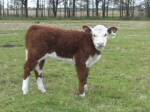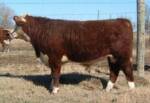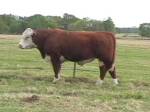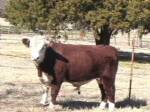Farms
Double
Farms
Double
Farms
Double
Newsletter
Table of Contents:
Preface
We chose another controversial article this month, but we didn't just do it to stir some interest. We did it because this issue had directly affected us as breeders! As always, this article will be personal opinion, but still based on factual information.
I. HUMOR
There's always a better way! (True story)
Shortly after buying our place in Canton, I went out and got me a old John Deere Model A (Popping Johnny) for about six or seven hundred dollars, so I could do some work around the place. Despite it being an antique, it was a good working tractor. It was equipped with a 3-point hitch, and I was able to do some box blading, break ground, and even mow with it. I also had a hay hook to move round bales, but when it came to unloading a trailer of hay it was limited. I could grab one bale at the end of the trailer, but was not able to off-load the rest, so I usually ended up manually unloading the remaining bales. Now when I say manually, I mean "by hand". I would spin the bale on it's axis (hit it like a football sled), which was a chore in itself, then I would get behind the bale and roll it off the trailer. I am a pretty good sized man, and back then I was in pretty good shape, so it really never became an issue when I was trailering a few bales to feed in the pasture or unloading a small amount in the lot. Just a little leg muscle and determination is all it took. In fact, I got so efficient at this method it never occurred to me there might be another way short of buying a tractor with a front end loader. Besides, I could get them off before you could say "spit"! However, there always comes a point when you realize that there has to be an easier way.
My realization came one summer when my son and I were off-loading our first "large" cutting of hay. I had sold the John Deere to a collector that past fall and found me a Farmall 130. Now a 130 is just about like a Farmall Cub; it was a more of a hobby, or light duty tractor. It was smaller than the John Deere, with even less horsepower, but it did come with a two point hitch, a mower, plows, blade, and discs. Besides, I had most of the harder dirt work done by then and the Farmall could handle the rest..or so I thought! Over two hundred round bales needed to be off-loaded within a couple of days. On about the fourth load on the first day in 90+ temperature Matt and I decided it was time to work smarter! (not the choice words I really used, but the meaning was the same) The 130 was too light and small to lift or pull the bales off the trailer so we had to come up with a plan. Borrowing a tractor was not an option, as we did not want to impose on a neighbor until it was our last resort. We had to devise a couple of plans that were simple, and not labor or equipment intensive. My first plan was to drive into the pasture to a tree which I knew had a large branch coming out just low enough to miss the cab of the truck, but catch the bales. Apparently I didn't have enough power in the truck to overcome the sheer weight of the round bales combined, and several rams into the limb with the hay made this obvious. Dang...scratch plan A!
Plan B was better! I would tie a long rope around the tree and pull the load off by wrapping the bales and driving away from the tree. A problem with this plan arose when we realized that we didn't have a rope long enough, but a quick search of my Uncles barn solved this problem. We got lucky and found about 150' of.......bungie cord! Yup, you heard me right, bungie cord. My Uncle had gone to an auction and had purchased this cord for who knows what reason. Now this wasn't just your average bungie cord, this stuff was about 1" in diameter. It was "bungie rope"! Surely it would have the strength to pull the hay off...surely! Matt and I tested it before deciding to giving it a try. Pulling against each other revealed no give in the cord "at all", this stuff was tough! What the heck, we threw the cord in the truck, proceeded to a large oak in the pasture, wrapped the tree and then wrapped the bales, tying the two ends of the cord in a knot. I had Matt stand to the rear and well to the side (behind a tree) just in case the cord or knot failed. I jumped back in the truck an began to pull slowly. After going about twenty feet or so, I looked out the window and noticed the cord was beginning to stretch, but every thing seemed to be holding so I kept going.
I guess it must have been at least fifty feet from the starting point when I realized Plan B ("Plan Bungie" ) probably wasn't going to work. So I let off the gas,....and yes, instantly the bungie cord yanked the truck, the trailer of hay, and me backward about 40' at a pretty good clip. The site was was enough to make my son scream with laughter..so I did it again!...:) We went to Plan C. I removed the bungie and placed it around one bale only, then did another encore. At about 40' the bale (which we figured was hung on the lip at the end of the trailer), shot up about 10' in the air flipping end over end and landed 20' from the trailer. In the time it had taken us to unload that one bale, we could have completed two trips the old way! We put up the cord and I humbly went a borrowed a tractor. Later that year (after we had moved all the hay for the season), I got me a new tractor with a front end loader. It has been one of the best investments I made on the farm. I have found numerous uses for that loader, and it has saved a lot of extra work. In fact, shortly after getting the tractor my wife asked me to go water the front flower bed which sits out on the road at the intersection of the two county roads. Normally, this chore involved filling some buckets with water, putting them in the truck, then driving out to the corner and "manually" watering with them, but not any more....I put Plan A into effect! I filled the loader with water from a hose near the house, then drove out to the flower bed and simply dumped it over! Of course I washed all the bark out of the flower bed, but it sure felt good to have a plan that worked! Don't tell Tina. :)
The moral of the story:
Reasonable intelligence does not always mean reasonable judgement!
From a cattle raisers point of view:
Sometimes you need options to make your operation more efficient, but stretching yourself too thin is not always the best answer.
II. INFORMATIVE
"DNA....is it playing with nature!" (opinion)
It seems as though technology has always played a part in the cattle business, although the new methods, better designs, and more efficiency have actually been pioneered by common sense, practicality, and good management! DNA technology is just an exaggerated example of this. Throughout the centuries, cattleraisers have attempted to define the breeds and the traits which would prove to be the most efficient and produce the most profit, based on the animals intended purpose. Breeds have been selected for beef, milk, or burden, and in some cases may be a combination of some or all of these designs. Phenotype, disposition, and dominant genetic traits became important factors to cattleraisers. We found it was profitable to identify cattle with early maturity and easy fleshing ability. We dehorned feeder cattle to reduce injury and prevent bruising to the carcass in transport. We took that step further by identifying animals with the homozygous trait, and then used statistical data to identify feed conversion efficiency, and bred our cattle accordingly. We began to breed cattle for specific characteristics like pigmentation, muscling and udder quality which resulted in fewer problems during the life of the animal, and provided the breeder with more profit down the road. We concentrated more on fertility, carcass quality traits, and moderation of frame then again adjusted the breeds and our cattle programs accordingly. We even turned feeder cattle from a two year time frame to finish, before slaughtering, to a 12 to 15 month window for market efficiency.
All these changes were motivated out of centuries of common sense approaches to producing a more functional, profitable, and marketable product, which in turn, has driven scientist to develop a technology to get us there faster. If you want cattle with no horns then they can, with DNA identification, tell you which animals are homozygous and even isolate the gene responsible! Marbling tenderness in beef? You bet! Eliminate the dwarf gene or isolate the hypotrichosis or diluted gene? Certainly! Heck, they can even sex an entire group of embryos and potentially clone any animal you want....or can afford! Yes, technology comes with a price, and the wealthy breeders and operations who wish to market these genetic matings have the advantage to hold that carrot! Just think, all this technology to gain a little more profit or to please the human palate. Will some good come of it? Most certainly, but money will be made first at the expense of trial and error. It may also prove to be a double edged sword as it is yet another way to pull profit from the breeder up front, as much as it may save the breeder later on. Feeder calf operations who are not concerned with traits affecting longevity, may see little need for DNA other than in their terminal sire's carcass traits. It is the registered breeder and the branded beef programs which may have the most to gain from DNA technology.
So where does nature come in? Nature has been doing this DNA thing for millions or years. It is called natural selection, and guess what...only the strong survive, or they adapt to the conditions. For many years, fruits and vegetables have seen this scientific genetic altering for the sake of market demand, and increased insect, disease or drought resistance, but in many circumstances these genetic alterations end up becoming sterile, or incapable of reproduction down the road. Foraging grasses are similar, and may revert back to a less desirable form after several years of production, and may even become more suspect to insects, disease, or the environment in the long run. When we remove genes, we reduce the gene pool, and increase the reoccurrence of the available genes. If there are other less desirable genes or "recessive" genes" in that remaining pool, then are we really helping genetic selection? We should all know what lessening the gene pool can do. It may even end up taking us in the opposite direction we intended to go! I am sure linebreeders must watch the kissing cousins very closely!
Identifying genetic abnormalities can be an important benefit of DNA technology, but altering the genetic code in the process could have severe consequences if nature has not been involved in the process over time. Grafting trees is only a fix, and it will not last in the seed of its fruit. Perhaps science does have the ability to create a herd based on embryo's that is all sexed the same, homozygous polled, pigmented, good uddered and without hypotrichosis or dwarfism, but does that mean they can be placed in a pasture environment, survive on grass, rebreed, and pass all the genetically important traits into their offspring? I don't believe so. Not to mention their gene pool has now been limited, leaving a window of opportunity for other even less desirable genes to occur more frequently. Is horned that bad? Is udder quality important for feeder calves? Cattle breeds have survived without pigmentation for centuries. The weak and small do not typically survive or see use in natural selection anyway.
DNA has helped the integrity of our breeds and our programs by verifying parentage, and in some cases identify animals with a "not so" Hereford past...if you know what I mean! Dishonest breeders will find it harder (not impossible) to cheat by not having their cattle just blood typed only. The DNA typing will prevent "full siblings" from being used and falsely reported as the sire or dam in place of another more popular, perhaps even "nationally recognized" or advertised sibling, as was possible under blood typing. DNA typing can also guarantee an animals genetic makeup to the unsuspecting buyer. DNA has helped us to identify the hypotrichosis gene in certain cattle, thus allowing us to adjust our breeding selections accordingly. It is certain that DNA will cause a rift in some herds, and we are still coincidently seeing many herds being dispersed on the top ends. We have have also seen some nationally advertised bulls disappear from the market with rumors of their misfortunes! Sure makes you wonder if we are practicing what we preach as breeders. It might be wise to have all your sires brought into your program DNA typed for lineage verification, before you commit them to being foundation sires in your program!
DNA technology is still somewhat controversial. There are benefits of this technology which have helped me first hand, and results which have changed my breed direction. I am prepared to embrace some of this technology, but am reluctant to say it is the best thing since the electric ice cream maker! Come to think of it, if the electric ice cream motor burned up or we lost electricity, we were back to the crank anyway. Hopefully, the things that got this technology going in the first place (common sense, practicality, and good management) will still hold their place in the cattle business despite these scientific shortcuts.
III.FARM NEWS:
Well what do you know! Double H Farms "does" have 3 DOD's for 2004. We called the AHA on our DOD which originally showed on this years printed DOD list, then disappeared off the corrected copy which they re-published! We reviewed the information and determined she still should have been a DOD for 2004....and we were right! The AHA has made the change, and apologized for the error. Only 1,487 Hereford females, both Horned and Polled, from 43 states were honored with this title. Texas was in the top ten states with only 55 animals claiming the title. To date, we have 5 DOD's currently working in our herd.
Another show heifer was committed to Laura Haeckel of Garland.
She will go into her possesion following her weaning. Thank you Laura!
Double H Farms is proud to announce a new herd sire!
From a state far far away comes.....................Feltons Jedi!
Yup, he is coming to Texas. Feltons Jedi is a trait leader bull
for milk, milk and growth, and back fat. He will be co-owned with
Oualline Polled Herefords, Stewart Polled Herefords and Willis
Polled Herefords. Thank you Margaret and Henry Wilson.
The Flush of our Donor cow LLL Deana 2099 80E to P606 was very successful. Look for a group of these embryo's to sell in the Hereford Breeders Online Auction this fall!
The Hereford Breeders Online Auction, slated for September of 2005, will probably be the next best time to pick up some of our upcoming breed age bulls and heifer calves. Check out the "Auctions" link on our "Sale Barn" page!
IV. CURRENT EVENTS:
A Hereford bull topped the CSU bull sale this year.....not Angus! A Hereford bull also topped the
Houston Livestock and Rodeo sale. It's happening all over the country. Hereford are in demand!
The CHB LLC program has grown by 41%!
The Texas All Star Sale will be in Sherman Texas on May 30th.
The Jr. Nationals will be held July 9th through the 16th in Milwaukee, Wisconsin this year.
V. HEREFORD HIGHLIGHTS:
FELTONS 621
03/22/2003
Well, that about wraps it up. We certainly hoped you enjoyed the newsletter! Email us and let us know what you think.
Performance on the Hoof!
Performance on the Hoof!
Performance on the Hoof!
April 2005
"Smokey" was purchased at the Feltons Dispersal Sale in October of 2003, where he was pulled straight off his mother. His mother and him, together, were a high selling lot in the sale. His purchase was a result of colaboration between Stewart Polled Herefords, Willis Polled Herefords and Double H Farms. We all saw promise in this young bull calf, as he had the advantage of coming from a trait leader bull, and an outstanding Dam. Feltons 621 boasted a very good set of EPD's and his confirmation was good, but he did not carry as strong of pigmentation as we would have liked. Smokey was halter broke, shown at a couple of shows, and put to work at 13 months of age running clean-up with a group of heifers and a couple of cows. He then came to Double H Farms were he spent 30 days on clean-up duty
We ended up with one resulting calf in the spring of this year. In an effort to market 621 beyond our herds we began the process of having him certified for semen sales in the fall of 2004. When we had his DNA profiled, we were suprised to find that Feltons Bear, his sire which was listed in the sale catalog, was in fact, not his sire! We immediately contacted the ranch manager who was in charge of the herd at the time of the sale and of the 2002 breedings, but even after several potential bull candadites were given by the manager, we still did not have a sire. After much research on our part, we were able to determine his sire through the AHA, and the DNA they had on file. We confirmed 621 by DNA comparison to Felton's Endurance 745. This was not the sire we had made the trip to Missouri for, and Smokey's performance EPD's were affected, but at least we knew his sire and were able to confirm him for semen sales. His new sire however, is also a trait leader bull with over 1,400 progeny recorded, and one of the top sires in the nation for calving ease EPD's. His dam, who he also confirmed too, is now a Dam of Distinction and Donor cow for Schu-Lar Polled Herefords in Kansas. Smokey's calves have weighed from the 60's to the mid eighties and have very good promise. Smokey's yearling weight was over a thousand pounds, but after being used in the pasture as a yearling bull, his growth was slowed considerably. We expect Smokey to top out at around 1,700 lbs. Pictures of his offspring can be seen on our web site by going to the bulls page. Embryo quality semen on Smokey is for sale. Look for more of his calves coming in the fall.
Well, that wraps up our Fourth newsletter, we hope you keep coming back!...:)
before going back to Stewart Polled Herefords.
No fear, Sis!
?
Do you really know who is working your pasture?
55
Cooper, Texas
doublehtx@gmail.com
The Harvey's
Tom and Tina





